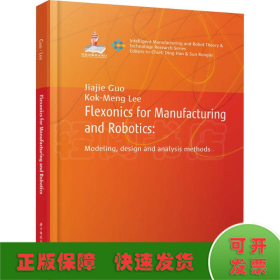
柔性机器人机构建模、设计与制造
全新正版 假一赔十 可开发票
¥ 97.15 7.6折 ¥ 128 全新
库存3件
北京海淀
认证卖家担保交易快速发货售后保障
作者郭家杰,李国民
出版社华中科技大学出版社
ISBN9787568040549
出版时间2019-02
装帧精装
开本16开
定价128元
货号1201844132
上书时间2024-05-22
- 最新上架
商品详情
- 品相描述:全新
- 商品描述
-
目录
Acknowledgements/ii
Table of contents/iii
LIST OF TABLES/vi
LIST OF FIGURES/vii
List of SYMBOLS/xi
List of ABBREVIATIONS/xiii
Preface/xv
CHAPTER I Introduction/1
1.1 Background and Motivation/1
1.2 Problem Description and Objectives/1
1.3 Review of Related Work/2
1.3.1 Compliant mechanisms/3
1.3.2 Joint constraint/4
1.3.3 Numerical methods for boundary value problems/6
1.3.4 Flexible robotics for structural health monitoring/7
1.3.5 Human-centered equipment (Exoskeleton)/9
1.3.6 Process state monitoring for manufacturing/10
1.3.7 Poultry-meat processing/13
1.4 Book Outline/14
CHAPTER II Fundamentals of mathematics/15
2.1 Differential Geometry/15
2.2 Curvature of a 3D Beam/16
2.3 Kinematics of a 3D Beam/18
2.4 Kinematics of an Annular Plate/23
2.5 Multiple Shooting Method/26
2.6 Summary/27
CHAPTER III Flexible Elements/28
3.1 Two-dimensional Beam/28
3.2 Three-dimensional Beam/31
3.3 Annular Plate/38
3.4 General Constraint/44
3.5 Summary/54
CHAPTER IV Flexonic Mobile Node/55
4.1 Design Concept/55
4.1.1 Dimension/56
4.1.2 Attachment/57
4.1.3 Flexibility/57
4.2 Functionalities/59
4.2.1 Sensor attachment/60
4.2.2 Convex corner negotiation (2D)/63
4.2.3 Convex corner negotiation (3D)/66
4.2.4 Concave corner negotiation/69
4.2.5 Environment monitoring/70
4.3 Experimental Validation/74
4.3.1 First prototype of FMN/74
4.3.2 Second prototype of FMN/82
4.4 Structural Health Monitoring/85
4.4.1 Steel frame structure/86
4.4.2 Space frame bridge/88
4.5 Summary/93
CHAPTER V Intelligent Manufacturing/94
5.1 Dynamic Analysis/94
5.1.1 Parametric Effects on |A(ωnm)| (DC1)/96
5.1.2 Illustrative example (DC1)/97
5.1.3 Numerical Verification (DC1 and DC2)/99
5.2 Parameter Identification and Sensing Configuration/101
5.2.1 Modal Damping Coefficients/102
5.2.2 Step Response/104
5.2.3 Robustness of Sensor Performance/105
5.2.4 Sensor Configuration Design/106
5.3 Formulation of Field Reconstruction/108
5.3.1 Field Reconstruction Algorithm/110
5.3.2 Numerical Verification/111
5.3.3 Numerical Evaluation of Reconstruction Algorithm/113
5.4 Experiment Results and Illustrative Application/114
5.4.1 Free Vibration of Non-rotating Plate/115
5.4.2 Field Reconstruction for Machining/118
5.5 Summary/121
CHAPTER VI Bio-inspired Exoskeleton/122
6.1 Human Knee Kinematics/122
6.2 Knee Joint Dynamics/125
6.3 Knee-exoskeleton Coupling/129
6.3.1 Coupled Kinematics/131
6.3.2 Coupled Dynamics/132
6.4 Experimental Investigation/132
6.4.1 Design Configurations/133
6.4.2 Experimental Test Bed/134
6.4.3 Experimental Methods/135
6.4.4 Results and Discussion/137
6.5 Summary/145
CHAPTER VII Musculoskeleton Modeling/146
7.1 Musculoskeletal System/146
7.1.1 Coordinates/147
7.1.2 Bio-joint Constraint/148
7.1.3 Clavicle Model/150
7.1.4 Soft Tissue Mechanics/154
7.2 Experimental Investigation/155
7.2.1 Elastic modulus of clavicle/155
7.2.2 Ligament mechanics/159
7.3 Illustrative Application to Wing Manipulation/162
7.4 Summary/165
References/167
Authors/176
内容摘要
This book formulates the large deformation of a 3-D compliant beam as a boundary value problem (BVP). Unlike other methods, such as finite element (FE) method, that formulate problems based on displacements and/or rotational angles, the BVP formulation has been derived using curvatures that are more fundamental in presenting nonlinear geometries. Since in the case of finite rotation, superposition holds for curvatures but not for rotational angles, the model is much simpler and the resulting computational process is more efficient. The above advantages have been employed in this research to analyze compliant mechanism designs using curvature-based beam models. Along with the method of deriving the compliant members in the same global reference frame, a generalized constraint acting on a compliant mechanism is presented to replace traditional boundary constraints (such as fixed, pinned or sliding constraint) where none or only one degree of freedom (DOF) is allowed. Inspired by the dexterity of a natural biological joint that offers efficient multi-axis rotation, this research extends to the modeling method of a generalized constraint (or referred to here as a bio-joint constraint) to develop designs emulating commonly observed human motions of multi-DOFs . Using a multiple shooting method (MSM), the BVP is treated as an initial value problem and higher order accuracy can be achieved than finite element (FE) methods.
主编推荐
Motivated by the recent developments and increasing interst in robotics and manufacturing, this book intends to report the theories and application results of the study on Flexible Mechatronics (Flexonics).
— 没有更多了 —












以下为对购买帮助不大的评价